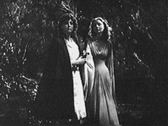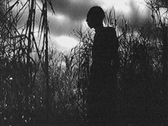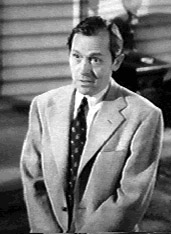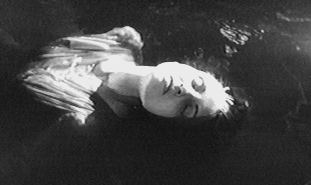About
the film's story
Canadian
nurse, Betsy Connel (Actress Francis
Dee), has been hired to travel to the Caribbean to
care for the ailing wife of plantation owner, Paul Holland
(played by Tom Conway). On board
the ship as they are crossing to his home on the island of
Saint Sebastion , Paul observes Betsy gazing out across the
moonlit waters, and confronts her:

Paul:
It's not beautiful ...
Betsy:
You read my thoughts Mr. Holland.
Paul:
It's easy enough to read the thoughts of a newcomer.
Everything seems beautiful because you don't understand.
Those flying fish ... they're not leaping for joy...
they're jumping in terror ... bigger fish want to
eat them. That luminous water... it takes its gleam
from millions of dead bodies. [plankton] There's
only death and decay here...
Betsy:
You can't believe that.
(They
look out from the ship and see a falling star)
Paul:
Everything good dies here ... even the stars...
|
 On her first day off after assuming her duties on the
plantation, Betsy meets Wesley, (Paul's younger brother, portrayed
by James Ellison), in town and
they stop for a drink at a restaurant. There the live music,
(provided by Sir Lancelot), infuriates Wesley, as the song
they hear describes the sordid past history of his family.
What had been merely sordid (the song reveals that Paul's
wife, Jessica, had been having an affair with Wesley before
she had entered into her catatonic zombie-like state....),
becomes downright frightening. Wesley drinks himself into
a stupor, leaving Betsy to fend for herself. Sir Lancelot
begins the tune anew, but adds new and rather ominous lyrics,
some referring to Betsy's relationship with the brothers.
The scene abruptly stops when the mother of Paul and Wesley
suddenly arrives, cheerfully looking down at her drunken son
and volunteering to help get him back on his horse so he can
return to the plantation. When Betsy protests that Wesley
is in no shape to ride, the mother answers, "Don't worry
about a sugar planter.... give him a horse and he'll ride
to his own funeral ...."
On her first day off after assuming her duties on the
plantation, Betsy meets Wesley, (Paul's younger brother, portrayed
by James Ellison), in town and
they stop for a drink at a restaurant. There the live music,
(provided by Sir Lancelot), infuriates Wesley, as the song
they hear describes the sordid past history of his family.
What had been merely sordid (the song reveals that Paul's
wife, Jessica, had been having an affair with Wesley before
she had entered into her catatonic zombie-like state....),
becomes downright frightening. Wesley drinks himself into
a stupor, leaving Betsy to fend for herself. Sir Lancelot
begins the tune anew, but adds new and rather ominous lyrics,
some referring to Betsy's relationship with the brothers.
The scene abruptly stops when the mother of Paul and Wesley
suddenly arrives, cheerfully looking down at her drunken son
and volunteering to help get him back on his horse so he can
return to the plantation. When Betsy protests that Wesley
is in no shape to ride, the mother answers, "Don't worry
about a sugar planter.... give him a horse and he'll ride
to his own funeral ...."
The
play on the meaning behind the word "zombie" is
repeated on several levels throughout this film.  For example, while
Paul Holland's nearly invalid wife is clearly a "zombie"
(and this is built upon throughout the film) Paul is shown
to also be something of a zombie. Insisting upon an unemotional,
official demeanor while dealing with Betsy and while performing
his responsibilities as the owner of the plantation, Paul
slips and slides in between a warmer, more emotive self and
a cold-hearted self. One senses the significance of this shift
when he attempts to discuss with Betsy the situation in his
family, especially with regards to the relationship between
himself and Wesley. As he elaborates his feelings about this
situation, the drums at the "Houmfort," (a place
where the local voodoo worshippers assemble), suddenly start
up. Immediately Paul snaps back into his zombie-like shell,
dismissing Betsy coldly and walking off alone.
For example, while
Paul Holland's nearly invalid wife is clearly a "zombie"
(and this is built upon throughout the film) Paul is shown
to also be something of a zombie. Insisting upon an unemotional,
official demeanor while dealing with Betsy and while performing
his responsibilities as the owner of the plantation, Paul
slips and slides in between a warmer, more emotive self and
a cold-hearted self. One senses the significance of this shift
when he attempts to discuss with Betsy the situation in his
family, especially with regards to the relationship between
himself and Wesley. As he elaborates his feelings about this
situation, the drums at the "Houmfort," (a place
where the local voodoo worshippers assemble), suddenly start
up. Immediately Paul snaps back into his zombie-like shell,
dismissing Betsy coldly and walking off alone.


Over
time, Betsy begins to feel drawn toward Paul, and in an effort
to combat her conflicting feelings, she becomes determined
to bring about the recovery of Paul's catatonic wife, Jessica.
When medical science fails, Betsy takes Jessica to the Houmfort
to see what the voodoo practitoners might be able to achieve.
After passing through the plantation's fields, and gaining
entrance passed the entranced guard (actor Darby
Jones), the two women come upon the steadily building
frenzy of a voodoo worship service.
 After observing the others there, Betsy stumbles across
the secret of the Houmfort: Paul and Wesley's mother hides
within a hut that serves as the focus of "divine communication"
from the voodoo gods .... only it is a quite human woman who
is pretending to be the divine being the worshippers are there
to beg advice from.
After observing the others there, Betsy stumbles across
the secret of the Houmfort: Paul and Wesley's mother hides
within a hut that serves as the focus of "divine communication"
from the voodoo gods .... only it is a quite human woman who
is pretending to be the divine being the worshippers are there
to beg advice from.
In
a later scene, the Doctor and Paul's mother have a confrontation
over Jessica's condition. She has become convinced that Jessica
is indeed a zombie, and proceeds to explain why. The Doctor
replies: "You're a very imaginative woman..."
As
the film progresses, it becomes evident that the zombie-like
Jessica is not new to the Houmfort ... in fact, there are
people among the voodoo worshippers who have been working
to get Jessica to come back to them ... permanently.
Wesley
becomes convinced, as is his mother, that the cause of Jessica's
state is voodoo, while Paul remains adamant that this explanation
is superstitious nonsense. Betsy dwells in between these two
poles, leaning one way and then the other.

From
the epilogue of the film:
"O
Lord God most holy, deliver them from the bitter pains
of eternal death. The woman was a wicked woman, and she
was dead in her own life. Yea Lord, dead in the selfishness
of her spirit, and the man followed her, her steps led
him down to evil, her feet took hold of death. Forgive
him, O Lord, who knows the secrets of all hearts. Yea
Lord, pity them who are dead, and give peace and happiness
to the living.
Conclusion:
Are
there zombies in "I Walked with a Zombie?" Or are
they people who appear to be zombies to those around them
because of cultural pressures and circumstances? As usual,
Val Lewton presents material which seems to reinforce
both views: Science (which discounts the supernatural) and
the supernatural (which discounts the science) each offering
solutions to the mysterious goings on.








 On her first day off after assuming her duties on the
plantation, Betsy meets Wesley, (Paul's younger brother, portrayed
by James Ellison), in town and
they stop for a drink at a restaurant. There the live music,
(provided by Sir Lancelot), infuriates Wesley, as the song
they hear describes the sordid past history of his family.
What had been merely sordid (the song reveals that Paul's
wife, Jessica, had been having an affair with Wesley before
she had entered into her catatonic zombie-like state....),
becomes downright frightening. Wesley drinks himself into
a stupor, leaving Betsy to fend for herself. Sir Lancelot
begins the tune anew, but adds new and rather ominous lyrics,
some referring to Betsy's relationship with the brothers.
The scene abruptly stops when the mother of Paul and Wesley
suddenly arrives, cheerfully looking down at her drunken son
and volunteering to help get him back on his horse so he can
return to the plantation. When Betsy protests that Wesley
is in no shape to ride, the mother answers, "Don't worry
about a sugar planter.... give him a horse and he'll ride
to his own funeral ...."
On her first day off after assuming her duties on the
plantation, Betsy meets Wesley, (Paul's younger brother, portrayed
by James Ellison), in town and
they stop for a drink at a restaurant. There the live music,
(provided by Sir Lancelot), infuriates Wesley, as the song
they hear describes the sordid past history of his family.
What had been merely sordid (the song reveals that Paul's
wife, Jessica, had been having an affair with Wesley before
she had entered into her catatonic zombie-like state....),
becomes downright frightening. Wesley drinks himself into
a stupor, leaving Betsy to fend for herself. Sir Lancelot
begins the tune anew, but adds new and rather ominous lyrics,
some referring to Betsy's relationship with the brothers.
The scene abruptly stops when the mother of Paul and Wesley
suddenly arrives, cheerfully looking down at her drunken son
and volunteering to help get him back on his horse so he can
return to the plantation. When Betsy protests that Wesley
is in no shape to ride, the mother answers, "Don't worry
about a sugar planter.... give him a horse and he'll ride
to his own funeral ...." For example, while
Paul Holland's nearly invalid wife is clearly a "zombie"
(and this is built upon throughout the film) Paul is shown
to also be something of a zombie. Insisting upon an unemotional,
official demeanor while dealing with Betsy and while performing
his responsibilities as the owner of the plantation, Paul
slips and slides in between a warmer, more emotive self and
a cold-hearted self. One senses the significance of this shift
when he attempts to discuss with Betsy the situation in his
family, especially with regards to the relationship between
himself and Wesley. As he elaborates his feelings about this
situation, the drums at the "Houmfort," (a place
where the local voodoo worshippers assemble), suddenly start
up. Immediately Paul snaps back into his zombie-like shell,
dismissing Betsy coldly and walking off alone.
For example, while
Paul Holland's nearly invalid wife is clearly a "zombie"
(and this is built upon throughout the film) Paul is shown
to also be something of a zombie. Insisting upon an unemotional,
official demeanor while dealing with Betsy and while performing
his responsibilities as the owner of the plantation, Paul
slips and slides in between a warmer, more emotive self and
a cold-hearted self. One senses the significance of this shift
when he attempts to discuss with Betsy the situation in his
family, especially with regards to the relationship between
himself and Wesley. As he elaborates his feelings about this
situation, the drums at the "Houmfort," (a place
where the local voodoo worshippers assemble), suddenly start
up. Immediately Paul snaps back into his zombie-like shell,
dismissing Betsy coldly and walking off alone. After observing the others there, Betsy stumbles across
the secret of the Houmfort: Paul and Wesley's mother hides
within a hut that serves as the focus of "divine communication"
from the voodoo gods .... only it is a quite human woman who
is pretending to be the divine being the worshippers are there
to beg advice from.
After observing the others there, Betsy stumbles across
the secret of the Houmfort: Paul and Wesley's mother hides
within a hut that serves as the focus of "divine communication"
from the voodoo gods .... only it is a quite human woman who
is pretending to be the divine being the worshippers are there
to beg advice from.
